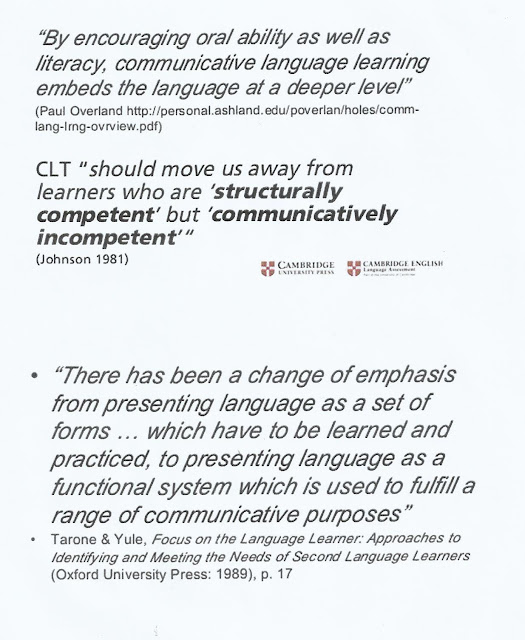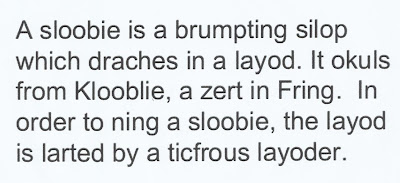This was the title of a recent Cambridge English Teacher webinar given by Peter Lucantoni. What follows is a summary of what he had to say including descriptions of his five suggested activities.
Communicative Language Learning (CLL)
1. From letters to grammar
Students must listen to a series of letters and then think of a meaningful phrase which uses each letter as the first letter of a word. The order in which they use the letters is not important.
For example, given - A D I F , students might produce:
As an extension, you could put students in groups and allow them to choose four letters which they then exchange with another group to make phrases. This is a good warmer or filler activity to reinforce grammar or vocabulary. It encourages creativity - students could make silly sentences, for example - as long as they are grammatically correct. It can be used with all levels. Generally, students like the element of competition involved.
2. Numbers and sizes ratios
(From 'Grammar Activity Book' published by CUP)
This activity focusses on general knowledge and guessing numbers and size. Learners then have the chance to produce their own version of the activity.
The world's tallest man is 2.5m tall.
The world's shortest man is 0.5m tall.
The ratio is 1 : 5.
The world's tallest man is five times as tall as the world's shortest man.
or:
The age of the Egyptian pyramids v the age of the Aztec pyramids - 1 : 2.
Aztec pyramids are twice as old as Egyptian pyramids.
or:
Number of rows on a chess board v number of squares - 1 : 8.
There are eight times as many squares on a chessboard as rows.
Other examples you could give:
The purpose of this activity is to get learners to think logically and critically, to use their general knowledge and to practise comparative forms.
3. Question to question
Sometimes we answer one question with another question, rather than giving a direct answer. Why do we do this?
The purpose of this activity is to teach functional language, to practise intonation and question forms, as a confidence booster, and to have fun!
4. Alphabet dialogue
Students create a paired dialogue so that each line begins with the next letter of the alphabet. e.g.:
For higher level students, you could combine 'alphabet dialogue' with 'question to question'.
The purpose of this activity is as a warmer, a confidence booster, to practise real time speaking using colloquial language, and to practise sentence starters.
In this activity, learners look at a text which contains nonsense words and try to make sense of it from a grammatical perspective. It is good for helping students with their 'decoding' skills and gives great opportunities for creative language use.
An example of a nonsense text:
Communicative Language Learning (CLL)
- CLL seeks to bring students beyond grammatical competence.
- Students need to decode language and manipulate it in private dialogue.
- This leads to communicative competence.
We need to move from knowing the forms and structures to using them in practice.
Some activities:
Students must listen to a series of letters and then think of a meaningful phrase which uses each letter as the first letter of a word. The order in which they use the letters is not important.
For example, given - A D I F , students might produce:
- A day in France
- Fantastic dreams are incredible
- I ate David's fruit
Students think of the vocabulary first and then the grammar they need to make a phrase. It becomes easier for students as they do more examples.
You can make this activity more challenging by telling the students that one of the words needs to be something specific - an adjective, an adverb, a pronoun or an irregular verb, if you are focusing on grammar, for example. If the emphasis is on lexis, you could ask that one of the words be a colour or a family member, for example.
2. Numbers and sizes ratios
(From 'Grammar Activity Book' published by CUP)
This activity focusses on general knowledge and guessing numbers and size. Learners then have the chance to produce their own version of the activity.
- Put learners into groups of 2 or 3
- Learners look at comparisons on the board or in a handout and discuss how big the difference is between them
- They then match the comparison to a ratio
- Then they write a sentence expressing the ratio
The world's tallest man is 2.5m tall.
The world's shortest man is 0.5m tall.
The ratio is 1 : 5.
The world's tallest man is five times as tall as the world's shortest man.
or:
The age of the Egyptian pyramids v the age of the Aztec pyramids - 1 : 2.
Aztec pyramids are twice as old as Egyptian pyramids.
or:
Number of rows on a chess board v number of squares - 1 : 8.
There are eight times as many squares on a chessboard as rows.
Other examples you could give:
- Number of circles on the Olympic flag / number of circles on the Japanese flag
- Paris, distance from London / Athens, distance from London
- World's highest mountain / world's highest waterfall
- Population of London / population of Mexico City
- Number of countries bordering Spain / number of countries bordering the USA
- one mile / sixteen kilometres
The purpose of this activity is to get learners to think logically and critically, to use their general knowledge and to practise comparative forms.
3. Question to question
Sometimes we answer one question with another question, rather than giving a direct answer. Why do we do this?
- for clarification
- because we don't know the answer
- to show interest
- to stall
- I'm sorry, what did you say?
- Really?
- What do you mean?
- Could you repeat that?
- Why do you ask?
- Don't you believe me?
and get them to put it into the correct order:
Then get students to create their own dialogues having given them the functional language they need. First they need to think of a context or situation (for example, parent/child, husband/wife), then write the dialogue, then read it aloud or act it out for their classmates to guess the context or situation.
The purpose of this activity is to teach functional language, to practise intonation and question forms, as a confidence booster, and to have fun!
Students create a paired dialogue so that each line begins with the next letter of the alphabet. e.g.:
- Ahmed, how are you?
- Bad, really bad!
- Come on, it can't be that bad!
- Do you think I'm joking?
- Everyone knows you're a joker.
For higher level students, you could combine 'alphabet dialogue' with 'question to question'.
The purpose of this activity is as a warmer, a confidence booster, to practise real time speaking using colloquial language, and to practise sentence starters.
5. Sloobie
In this activity, learners look at a text which contains nonsense words and try to make sense of it from a grammatical perspective. It is good for helping students with their 'decoding' skills and gives great opportunities for creative language use.
An example of a nonsense text:
Students need to identify parts of speech by looking at the word order. For example, 'brumpting' and 'ticfrous' must be adjectives.
You can ask students to speculate on meaning by asking questions such as:
- What is a sloobie?
- What does it do?
They can then discuss and justify their answers in groups. Alternatively, for lower level students, you can give the students the words they have to substitute into the text:
You can get students to create their own 'sloobie' for their classmates to solve by writing real sentences and then substituting some of the words for nonsense words.
The purpose of this activity is to practise guessing meaning from context, to identify parts of speech and to be creative.
It's important to model all of these activities well and to give students the functional language they will need to complete them.











No comments:
Post a Comment